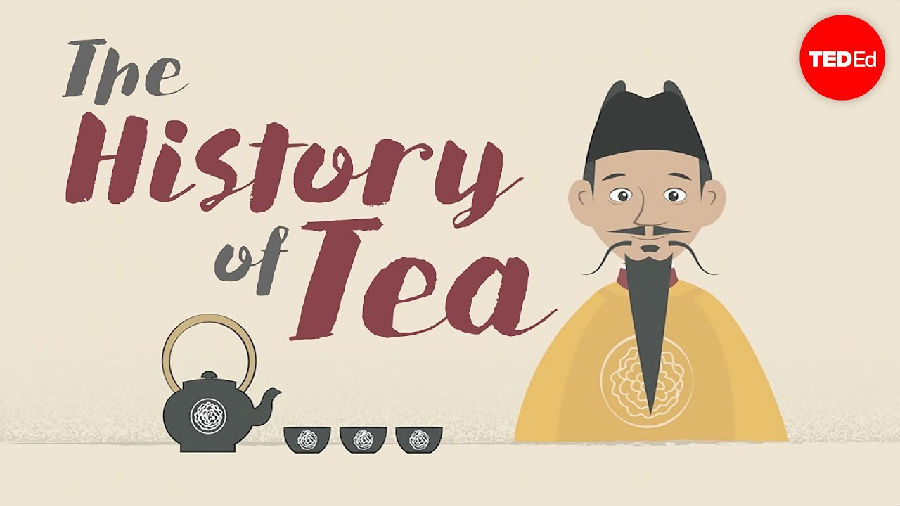(单词翻译:单击)
During a long day spent roaming the forest in search of edible grains and herbs,
在森林里转了一整天寻找可吃的谷物和草药,
the weary divine farmer Shennong accidentally poisoned himself 72 times.
疲惫不堪的神农,已经中毒了72次。
But before the poisons could end his life, a leaf drifted into his mouth.
但就在他毒发身亡之前,一片叶子飘落进他的嘴中。
He chewed on it and it revived him, and that is how we discovered tea.
他嚼了嚼树叶,又恢复了活力,这就是发现茶叶的过程。
Or so an ancient legend goes at least.
至少古代神话故事是这样讲述的。
Tea doesn't actually cure poisonings,
茶叶其实并不能解毒,
but the story of Shennong, the mythical Chinese inventor of agriculture, highlights tea's importance to ancient China.
但是神农作为中国农业的发明者,突出了茶在古代中国的重要性。
Archaeological evidence suggests tea was first cultivated there as early as 6,000 years ago,
考古证据显示,茶最早培育在中国,距今有6000年左右,
or 1,500 years before the pharaohs built the Great Pyramids of Giza.
比法老修建金字塔早了1500年。
That original Chinese tea plant is the same type that's grown around the world today,
早先的中国茶作物与现在遍及全球的茶树一致,
yet it was originally consumed very differently.
但食用它的方法与现在却大不相同。
It was eaten as a vegetable or cooked with grain porridge.
它最早作为蔬菜食用或用来煮粥。
Tea only shifted from food to drink 1,500 years ago
它从食品变为饮品是在1500年前,
when people realized that a combination of heat and moisture could create a complex and varied taste out of the leafy green.
那时的人们意识到加热和水汽可以使这种树叶产生出复杂而多变的口感。
After hundreds of years of variations to the preparation method, the standard became to heat tea,
制茶方式经过了几百年的演化,形成了现在的标准流程,
pack it into portable cakes, grind it into powder, mix with hot water, and create a beverage called muo cha, or matcha.
包括加热茶叶,压制成便携的茶饼,磨成粉末冲入热水,由此便得到了抹茶。
Matcha became so popular that a distinct Chinese tea culture emerged.
抹茶风靡一时,独特的中国茶文化也由此产生。
Tea was the subject of books and poetry, the favorite drink of emperors, and a medium for artists.
茶变成了诗歌和书籍的主题,成为了皇帝最爱的饮料,也是艺术家创作的载体。
They would draw extravagant pictures in the foam of the tea,
他们能够在茶水泡沫中作画,
very much like the espresso art you might see in coffee shops today.
与现在咖啡店在蒸馏咖啡上作画十分相似。
In the 9th century during the Tang Dynasty, a Japanese monk brought the first tea plant to Japan.
在9世纪,唐朝时期一位日本和尚将第一柱茶作物带到日本。
The Japanese eventually developed their own unique rituals around tea, leading to the creation of the Japanese tea ceremony.
日本人最终形成了自己独特的品茶习惯,从而产生了茶道。
And in the 14th century during the Ming Dynasty,
在14世纪的明朝时期,
the Chinese emperor shifted the standard from tea pressed into cakes to loose leaf tea.
中国的皇帝将制作茶饼这种方式转变为分散的茶叶。
At that point, China still held a virtual monopoly on the world's tea trees,
此时,中国仍然独占着世界上全部的茶树,
making tea one of three essential Chinese export goods, along with porcelain and silk.
茶树与陶瓷和丝绸共同作为中国出口的三大商品。

This gave China a great deal of power and economic influence as tea drinking spread around the world.
这给中国带来了强大的权力和经济影响力,因为此时喝茶这一习俗已遍及全球。
That spread began in earnest around the early 1600s when Dutch traders brought tea to Europe in large quantities.
这股风潮在1600年代达到最盛,在此期间,荷兰商人将茶大量带到欧洲。
Many credit Queen Catherine of Braganza, a Portuguese noble woman,
很多人认为葡萄牙尊贵的女王凯瑟琳皇后,
for making tea popular with the English aristocracy when she married King Charles II in 1661.
在1661年嫁给英国国王查尔斯二世,从而使英国贵族阶层爱上了茶。
At the time, Great Britain was in the midst of expanding its colonial influence and becoming the new dominant world power.
当时的英国正在扩张殖民地,并日渐成为世界的领导力量。
And as Great Britain grew, interest in tea spread around the world.
随着英国的壮大,对茶的兴趣遍及世界。
By 1700, tea in Europe sold for ten times the price of coffee and the plant was still only grown in China.
1700年的欧洲市场上,茶的价格已经达到了咖啡的十倍,但此时茶树仍然只在中国生长。
The tea trade was so lucrative that the world's fastest sailboat, the clipper ship,
茶叶贸易看起来如此诱人,世界上最快的帆船
was born out of intense competition between Western trading companies.
就因西方贸易公司之间的激烈竞争而诞生。
All were racing to bring their tea back to Europe first to maximize their profits.
这些船只飞速地将茶叶带回欧洲,从而最大化公司的利润。
At first, Britain paid for all this Chinese tea with silver.
起初,英国用银币支付茶叶。
When that proved too expensive, they suggested trading tea for another substance, opium.
当这变得过于昂贵时,他们提出用鸦片进行交换。
This triggered a public health problem within China as people became addicted to the drug.
这引发了中国的公共健康问题,人们吸食鸦片成瘾。
Then in 1839, a Chinese official ordered his men to destroy massive British shipments of opium
到了1839年,一位中国官员下令销毁了大量英国运来的鸦片,
as a statement against Britain's influence over China.
这被视为对抗英国对中国施加的影响。
This act triggered the First Opium War between the two nations.
这一行为触发了两国之间第一次鸦片战争。
Fighting raged up and down the Chinese coast
斗争在中国沿岸此起彼伏,
until 1842 when the defeated Qing Dynasty ceded the port of Hong Kong to the British and resumed trading on unfavorable terms.
直到1842年清政府战败,割让香港岛给英国并接受贸易不平等条款。
The war weakened China's global standing for over a century.
这场战争削弱了中国的全球地位长达一个世纪。
The British East India company also wanted to be able to grow tea themselves and further control the market.
英国的东印度公司也想要种植茶作物,并进一步控制茶市场。
So they commissioned botanist Robert Fortune to steal tea from China in a covert operation.
因此他们委派植物学家Robert Fortune秘密行动,前往中国偷取茶叶。
He disguised himself and took a perilous journey through China's mountainous tea regions,
他伪装自己,开始了这段危险的旅程,他经过中国种植茶的山区,
eventually smuggling tea trees and experienced tea workers into Darjeeling, India.
偷运出了茶树以及有经验的制茶工人,将他们带到印度大吉岭。
From there, the plant spread further still, helping drive tea's rapid growth as an everyday commodity.
经由此,茶树广泛传播,促进了茶叶迅速普及成为了日常饮品。
Today, tea is the second most consumed beverage in the world after water,
现在,茶的饮用量仅次于水位于世界第二,
and from sugary Turkish Rize tea, to salty Tibetan butter tea,
从甜味的土耳其黑茶,到咸味的西藏酥油茶,
there are almost as many ways of preparing the beverage as there are cultures on the globe.
茶的制作方法如此之多,有如世界上不同文化的数量。


